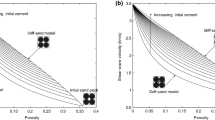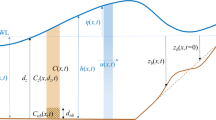Abstract
A new theoretical model is formulated to describe internal movement mechanisms of the sand ridges and sand waves based on the momentum equation of a solid-liquid two-phase flow under a shear flow. Coupling this equation with two-dimensional shallow water equations and wave reflection-diffraction equation of mild slope, a two-dimensional coupling model is established and a validation is carried out by observed hydrogeology, tides, waves and sediment. The numerical results are compared with available observations. Satisfactory agreements are achieved. This coupling model is then applied to the Dongfang 1-1 Gas Field area to quantitatively predict the movement and evolution of submarine sand ridges and sand waves. As a result, it is found that the sand ridges and sand waves movement distance increases year by year, but the development trend is stable.
Similar content being viewed by others
References
Besio G, Blondeaux P, Brocchini M, et al. 2004. On the modeling of sand wave migration. Journal of Geophysical Research, 109(C4): C04018
Borsje B W, Roos P C, Kranenburg W M, et al. 2013. Modeling tidal sand wave formation in a numerical shallow water model: The role of turbulence formulation. Continental Shelf Research, 60: 17–27
Fan Yu. 2015. Research on water-sediment two phase flow theory and sediment transportation problems in pipes of diversion project (in Chinese)[dissertation]. Tianjin: Tianjin University
Feng Wenke, Li Weifeng, Shi Yaohong. 1994. Research on geomorphology dynamics of submarine sand waves in northern South China Sea. Haiyang Xuebao (in Chinese), 16(6): 92–99
Hulscher S J M H. 1996. Tidal-induced large-scale regular bed form patterns in a three-dimensional shallow water model. Journal of Geophysical Research, 101(C9): 20727–20744
Li Daming, Bai Zhigang, Zhu Zhixia. 1999. A sediment mathematical model for forecasting the processes of sea bed in long term under combined action of tidal currents and waves. China Harbour Engineering (in Chinese), (5): 33–40
Li Daming, Li Xiaoyu, Li Yanqing, et al. 2015. Flow pattern analysis of linear gradient flow distribution. Applied Mathematics and Mechanics, 36(1): 81–106
Li Yong, Liu Mian, Jiang Wenbing, et al. 2011. Process control of the sand wave migration in Beibu Gulf of the South China Sea Journal of Hydrodynamics, Ser B, 23(4): 439–446
Li Zewen, Yan Jun, Luan Zhendong, et al. 2010. Analysis on spatial differences of morphology and mobility of the submarine sand waves in Southwest Hainan Island. Marine Geology Letters (in Chinese), 26(7): 24–32
Liu Zhenxia, Xia Dongxing. 1983. A preliminary study of tidal current ridges. Oceanologia et Limnologia Sinica (in Chinese), 14(3): 286–296
Németh A A, Hulscher S J M H, de Vriend H J. 2002. Modelling sand wave migration in shallow shelf seas. Continental Shelf Research, 22(18–19): 2795–2806
Rubin D M, Hunter R E. 1982. Bedform climbing in theory and nature. Sedimentology, 29(1): 121–138
Rubin D M, McCulloch D S. 1980. Single and superimposed bedforms: a synthesis of San Francisco Bay and flume observations. Sedimentary Geology, 26(1–3): 207–231
Shinohara K, Tsubaki T. 1959. On the characteristics of sand waves formed upon the beds of open channels and rivers. Reports of Research Institute for Applied Mechanics, 7(25): 15–45
Terwindt J H J. 1971. Sand waves in the southern bight of the North Sea. Marine Geology, 10(1): 51–67
Wang Shangyi, Li Daming. 1994. Dynamic analysis on the submarine sand waves of the continental shelf and continental slope at the Pearl River mouth basin in South China Sea. Haiyang Xuebao (in Chinese), 16(6): 122–132
Xia Dongxing, Wu Sangyun, Liu Zhenxia, et al. 2001. Research on the Activity of Submarine Sand Waves off Dongfang, Hainan Island. Journal of Oceanography of Huanghai & Bohai Seas (in Chinese), 19(1): 17–24
Author information
Authors and Affiliations
Corresponding author
Additional information
Foundation item: The National Natural Science Foundation of China under contract No.51079095; the Science Fund for Creative Research Groups of the National Natural Science Foundation of China under contract No. 51021004.
Rights and permissions
About this article
Cite this article
Li, D., Wang, X., Wang, X. et al. Sediment mathematical model for sand ridges and sand waves. Acta Oceanol. Sin. 35, 141–149 (2016). https://doi.org/10.1007/s13131-016-0853-6
Received:
Accepted:
Published:
Issue Date:
DOI: https://doi.org/10.1007/s13131-016-0853-6




